Wei Fang
Anatomy-Aware Low-Dose CT Denoising via Pretrained Vision Models and Semantic-Guided Contrastive Learning
Aug 11, 2025Abstract:To reduce radiation exposure and improve the diagnostic efficacy of low-dose computed tomography (LDCT), numerous deep learning-based denoising methods have been developed to mitigate noise and artifacts. However, most of these approaches ignore the anatomical semantics of human tissues, which may potentially result in suboptimal denoising outcomes. To address this problem, we propose ALDEN, an anatomy-aware LDCT denoising method that integrates semantic features of pretrained vision models (PVMs) with adversarial and contrastive learning. Specifically, we introduce an anatomy-aware discriminator that dynamically fuses hierarchical semantic features from reference normal-dose CT (NDCT) via cross-attention mechanisms, enabling tissue-specific realism evaluation in the discriminator. In addition, we propose a semantic-guided contrastive learning module that enforces anatomical consistency by contrasting PVM-derived features from LDCT, denoised CT and NDCT, preserving tissue-specific patterns through positive pairs and suppressing artifacts via dual negative pairs. Extensive experiments conducted on two LDCT denoising datasets reveal that ALDEN achieves the state-of-the-art performance, offering superior anatomy preservation and substantially reducing over-smoothing issue of previous work. Further validation on a downstream multi-organ segmentation task (encompassing 117 anatomical structures) affirms the model's ability to maintain anatomical awareness.
Event2Vec: Processing neuromorphic events directly by representations in vector space
Apr 21, 2025



Abstract:The neuromorphic event cameras have overwhelming advantages in temporal resolution, power efficiency, and dynamic range compared to traditional cameras. However, the event cameras output asynchronous, sparse, and irregular events, which are not compatible with mainstream computer vision and deep learning methods. Various methods have been proposed to solve this issue but at the cost of long preprocessing procedures, losing temporal resolutions, or being incompatible with massively parallel computation. Inspired by the great success of the word to vector, we summarize the similarities between words and events, then propose the first event to vector (event2vec) representation. We validate event2vec on classifying the ASL-DVS dataset, showing impressive parameter efficiency, accuracy, and speed than previous graph/image/voxel-based representations. Beyond task performance, the most attractive advantage of event2vec is that it aligns events to the domain of natural language processing, showing the promising prospect of integrating events into large language and multimodal models. Our codes, models, and training logs are available at https://github.com/fangwei123456/event2vec.
Mamba-3D as Masked Autoencoders for Accurate and Data-Efficient Analysis of Medical Ultrasound Videos
Mar 26, 2025Abstract:Ultrasound videos are an important form of clinical imaging data, and deep learning-based automated analysis can improve diagnostic accuracy and clinical efficiency. However, the scarcity of labeled data and the inherent challenges of video analysis have impeded the advancement of related methods. In this work, we introduce E-ViM$^3$, a data-efficient Vision Mamba network that preserves the 3D structure of video data, enhancing long-range dependencies and inductive biases to better model space-time correlations. With our design of Enclosure Global Tokens (EGT), the model captures and aggregates global features more effectively than competing methods. To further improve data efficiency, we employ masked video modeling for self-supervised pre-training, with the proposed Spatial-Temporal Chained (STC) masking strategy designed to adapt to various video scenarios. Experiments demonstrate that E-ViM$^3$ performs as the state-of-the-art in two high-level semantic analysis tasks across four datasets of varying sizes: EchoNet-Dynamic, CAMUS, MICCAI-BUV, and WHBUS. Furthermore, our model achieves competitive performance with limited labels, highlighting its potential impact on real-world clinical applications.
PLAY2PROMPT: Zero-shot Tool Instruction Optimization for LLM Agents via Tool Play
Mar 18, 2025



Abstract:Large language models (LLMs) are increasingly integrated with specialized external tools, yet many tasks demand zero-shot tool usage with minimal or noisy documentation. Existing solutions rely on manual rewriting or labeled data for validation, making them inapplicable in true zero-shot settings. To address these challenges, we propose PLAY2PROMPT, an automated framework that systematically "plays" with each tool to explore its input-output behaviors. Through this iterative trial-and-error process, PLAY2PROMPT refines tool documentation and generates usage examples without any labeled data. These examples not only guide LLM inference but also serve as validation to further enhance tool utilization. Extensive experiments on real-world tasks demonstrate that PLAY2PROMPT significantly improves zero-shot tool performance across both open and closed models, offering a scalable and effective solution for domain-specific tool integration.
MRS: A Fast Sampler for Mean Reverting Diffusion based on ODE and SDE Solvers
Feb 11, 2025Abstract:In applications of diffusion models, controllable generation is of practical significance, but is also challenging. Current methods for controllable generation primarily focus on modifying the score function of diffusion models, while Mean Reverting (MR) Diffusion directly modifies the structure of the stochastic differential equation (SDE), making the incorporation of image conditions simpler and more natural. However, current training-free fast samplers are not directly applicable to MR Diffusion. And thus MR Diffusion requires hundreds of NFEs (number of function evaluations) to obtain high-quality samples. In this paper, we propose a new algorithm named MRS (MR Sampler) to reduce the sampling NFEs of MR Diffusion. We solve the reverse-time SDE and the probability flow ordinary differential equation (PF-ODE) associated with MR Diffusion, and derive semi-analytical solutions. The solutions consist of an analytical function and an integral parameterized by a neural network. Based on this solution, we can generate high-quality samples in fewer steps. Our approach does not require training and supports all mainstream parameterizations, including noise prediction, data prediction and velocity prediction. Extensive experiments demonstrate that MR Sampler maintains high sampling quality with a speedup of 10 to 20 times across ten different image restoration tasks. Our algorithm accelerates the sampling procedure of MR Diffusion, making it more practical in controllable generation.
Channel-wise Parallelizable Spiking Neuron with Multiplication-free Dynamics and Large Temporal Receptive Fields
Jan 24, 2025Abstract:Spiking Neural Networks (SNNs) are distinguished from Artificial Neural Networks (ANNs) for their sophisticated neuronal dynamics and sparse binary activations (spikes) inspired by the biological neural system. Traditional neuron models use iterative step-by-step dynamics, resulting in serial computation and slow training speed of SNNs. Recently, parallelizable spiking neuron models have been proposed to fully utilize the massive parallel computing ability of graphics processing units to accelerate the training of SNNs. However, existing parallelizable spiking neuron models involve dense floating operations and can only achieve high long-term dependencies learning ability with a large order at the cost of huge computational and memory costs. To solve the dilemma of performance and costs, we propose the mul-free channel-wise Parallel Spiking Neuron, which is hardware-friendly and suitable for SNNs' resource-restricted application scenarios. The proposed neuron imports the channel-wise convolution to enhance the learning ability, induces the sawtooth dilations to reduce the neuron order, and employs the bit shift operation to avoid multiplications. The algorithm for design and implementation of acceleration methods is discussed meticulously. Our methods are validated in neuromorphic Spiking Heidelberg Digits voices, sequential CIFAR images, and neuromorphic DVS-Lip vision datasets, achieving the best accuracy among SNNs. Training speed results demonstrate the effectiveness of our acceleration methods, providing a practical reference for future research.
Flexible and Scalable Deep Dendritic Spiking Neural Networks with Multiple Nonlinear Branching
Dec 09, 2024Abstract:Recent advances in spiking neural networks (SNNs) have a predominant focus on network architectures, while relatively little attention has been paid to the underlying neuron model. The point neuron models, a cornerstone of deep SNNs, pose a bottleneck on the network-level expressivity since they depict somatic dynamics only. In contrast, the multi-compartment models in neuroscience offer remarkable expressivity by introducing dendritic morphology and dynamics, but remain underexplored in deep learning due to their unaffordable computational cost and inflexibility. To combine the advantages of both sides for a flexible, efficient yet more powerful model, we propose the dendritic spiking neuron (DendSN) incorporating multiple dendritic branches with nonlinear dynamics. Compared to the point spiking neurons, DendSN exhibits significantly higher expressivity. DendSN's flexibility enables its seamless integration into diverse deep SNN architectures. To accelerate dendritic SNNs (DendSNNs), we parallelize dendritic state updates across time steps, and develop Triton kernels for GPU-level acceleration. As a result, we can construct large-scale DendSNNs with depth comparable to their point SNN counterparts. Next, we comprehensively evaluate DendSNNs' performance on various demanding tasks. By modulating dendritic branch strengths using a context signal, catastrophic forgetting of DendSNNs is substantially mitigated. Moreover, DendSNNs demonstrate enhanced robustness against noise and adversarial attacks compared to point SNNs, and excel in few-shot learning settings. Our work firstly demonstrates the possibility of training bio-plausible dendritic SNNs with depths and scales comparable to traditional point SNNs, and reveals superior expressivity and robustness of reduced dendritic neuron models in deep learning, thereby offering a fresh perspective on advancing neural network design.
ETTFS: An Efficient Training Framework for Time-to-First-Spike Neuron
Oct 31, 2024Abstract:Spiking Neural Networks (SNNs) have attracted considerable attention due to their biologically inspired, event-driven nature, making them highly suitable for neuromorphic hardware. Time-to-First-Spike (TTFS) coding, where neurons fire only once during inference, offers the benefits of reduced spike counts, enhanced energy efficiency, and faster processing. However, SNNs employing TTFS coding often suffer from diminished classification accuracy. This paper presents an efficient training framework for TTFS that not only improves accuracy but also accelerates the training process. Unlike most previous approaches, we first identify two key issues limiting the performance of TTFS neurons: information disminishing and imbalanced membrane potential distribution. To address these challenges, we propose a novel initialization strategy. Additionally, we introduce a temporal weighting decoding method that aggregates temporal outputs through a weighted sum, supporting BPTT. Moreover, we re-evaluate the pooling layer in TTFS neurons and find that average pooling is better suited than max-pooling for this coding scheme. Our experimental results show that the proposed training framework leads to more stable training and significant performance improvements, achieving state-of-the-art (SOTA) results on both the MNIST and Fashion-MNIST datasets.
StyleSeg V2: Towards Robust One-shot Segmentation of Brain Tissue via Optimization-free Registration Error Perception
May 06, 2024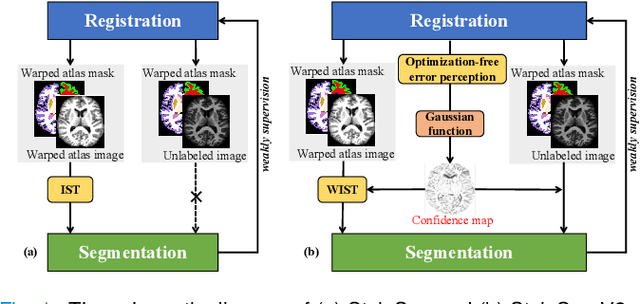
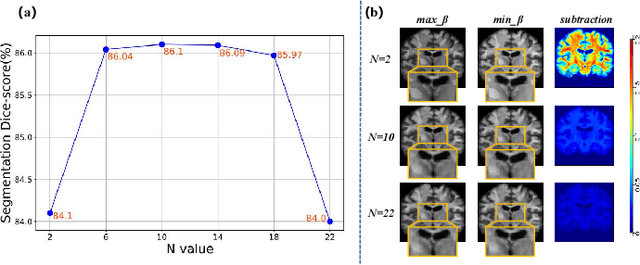
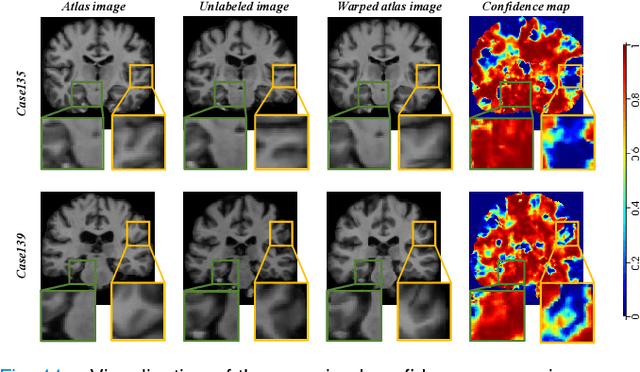

Abstract:One-shot segmentation of brain tissue requires training registration-segmentation (reg-seg) dual-model iteratively, where reg-model aims to provide pseudo masks of unlabeled images for seg-model by warping a carefully-labeled atlas. However, the imperfect reg-model induces image-mask misalignment, poisoning the seg-model subsequently. Recent StyleSeg bypasses this bottleneck by replacing the unlabeled images with their warped copies of atlas, but needs to borrow the diverse image patterns via style transformation. Here, we present StyleSeg V2, inherited from StyleSeg but granted the ability of perceiving the registration errors. The motivation is that good registration behaves in a mirrored fashion for mirrored images. Therefore, almost at no cost, StyleSeg V2 can have reg-model itself "speak out" incorrectly-aligned regions by simply mirroring (symmetrically flipping the brain) its input, and the registration errors are symmetric inconsistencies between the outputs of original and mirrored inputs. Consequently, StyleSeg V2 allows the seg-model to make use of correctly-aligned regions of unlabeled images and also enhances the fidelity of style-transformed warped atlas image by weighting the local transformation strength according to registration errors. The experimental results on three public datasets demonstrate that our proposed StyleSeg V2 outperforms other state-of-the-arts by considerable margins, and exceeds StyleSeg by increasing the average Dice by at least 2.4%.
CycleINR: Cycle Implicit Neural Representation for Arbitrary-Scale Volumetric Super-Resolution of Medical Data
Apr 07, 2024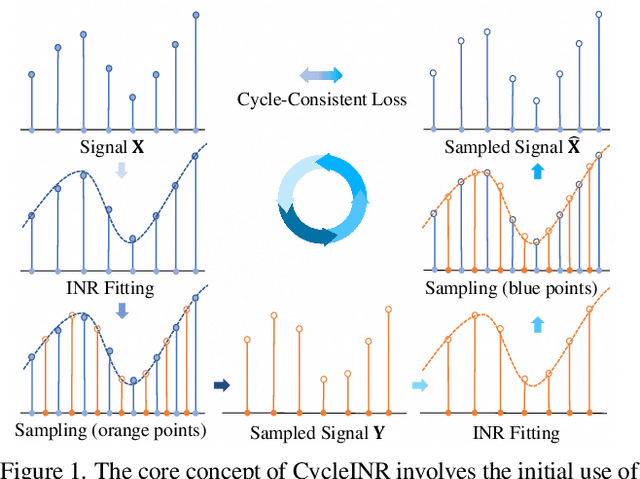
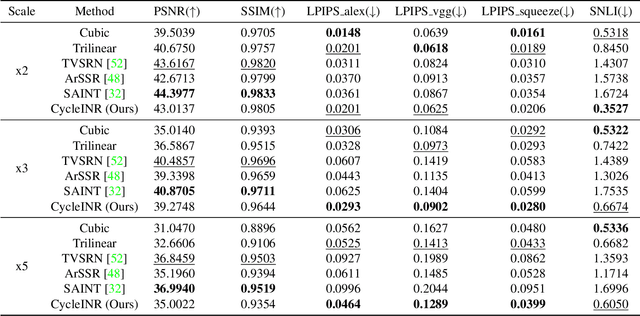
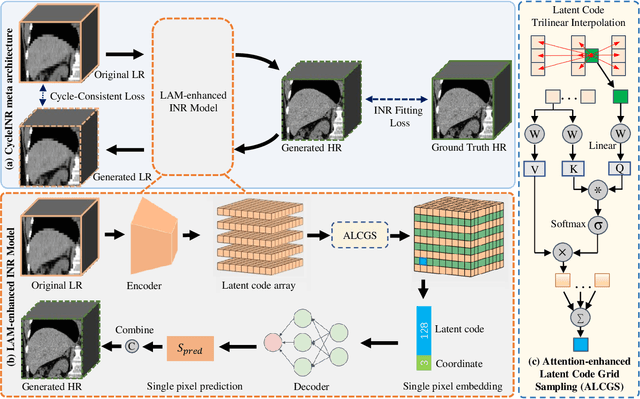

Abstract:In the realm of medical 3D data, such as CT and MRI images, prevalent anisotropic resolution is characterized by high intra-slice but diminished inter-slice resolution. The lowered resolution between adjacent slices poses challenges, hindering optimal viewing experiences and impeding the development of robust downstream analysis algorithms. Various volumetric super-resolution algorithms aim to surmount these challenges, enhancing inter-slice resolution and overall 3D medical imaging quality. However, existing approaches confront inherent challenges: 1) often tailored to specific upsampling factors, lacking flexibility for diverse clinical scenarios; 2) newly generated slices frequently suffer from over-smoothing, degrading fine details, and leading to inter-slice inconsistency. In response, this study presents CycleINR, a novel enhanced Implicit Neural Representation model for 3D medical data volumetric super-resolution. Leveraging the continuity of the learned implicit function, the CycleINR model can achieve results with arbitrary up-sampling rates, eliminating the need for separate training. Additionally, we enhance the grid sampling in CycleINR with a local attention mechanism and mitigate over-smoothing by integrating cycle-consistent loss. We introduce a new metric, Slice-wise Noise Level Inconsistency (SNLI), to quantitatively assess inter-slice noise level inconsistency. The effectiveness of our approach is demonstrated through image quality evaluations on an in-house dataset and a downstream task analysis on the Medical Segmentation Decathlon liver tumor dataset.
 Add to Chrome
Add to Chrome Add to Firefox
Add to Firefox Add to Edge
Add to Edge